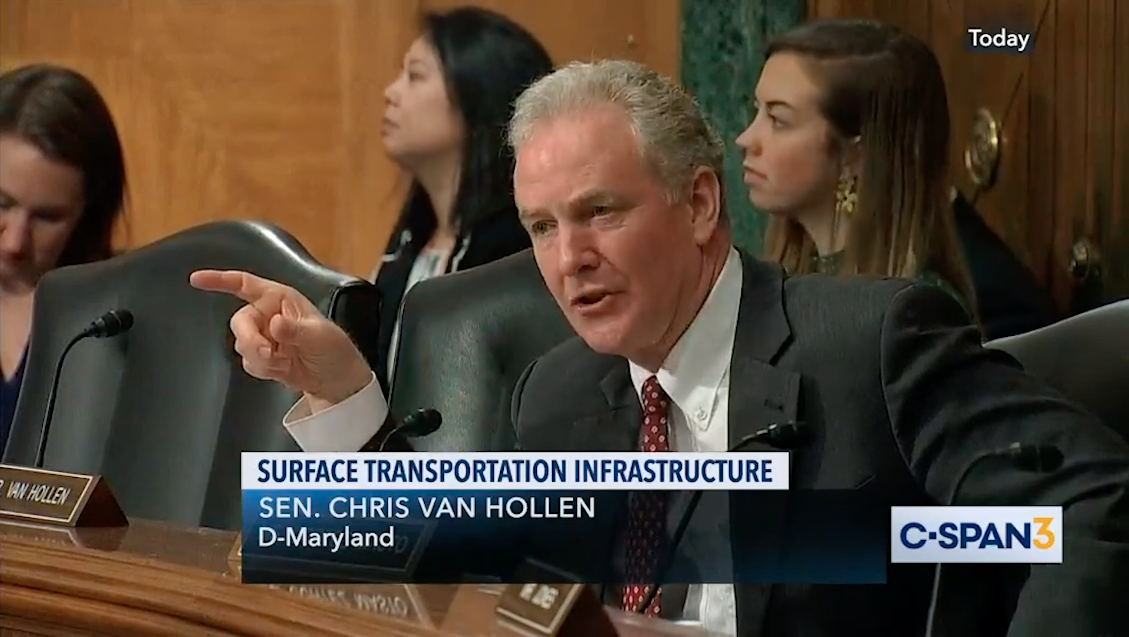Microtransit is gaining speed all around the world — including in the United States Senate. At a recent Senate Banking, Housing and Urban Affairs Committee meeting held to discuss the reauthorization of the Fixing America’s Surface Transportation Act, committee members addressed ways to expand public transportation to rural communities, transition to electric vehicles, and fund infrastructure projects across the United States (especially considering 45% of Americans have no access to public transit at all).
It was here that Sen. Chris Van Hollen (D-Maryland) and former Sen. Doug Jones (D-Alabama) both made points to introduce an increasingly popular public transportation development to the Senate floor: Microtransit. Citing a recent on-demand public transportation deployment in Birmingham, Jones asked other committee members to take a closer look at how microtransit can solve mobility issues around the world, especially as it relates to rural communities. I have a lot of rural areas, and I know that’s a big issue for everybody on this panel. How can we expand those kinds of microtransit pilot programs into rural areas? “In December of last year, the City of Birmingham launched a new transportation microtransit pilot program with Via. Birmingham On-Demand is an on-demand shared ride service with a fleet of vans that can accommodate six passengers. It’s wheelchair accessible. It complements and extends our public transportation. For select areas of the city, it focuses on increasing, and improving connections for work, education, entertainment venues — all for a flat rate of $1.50.
“I would like to ask how those things can alleviate some of the public transportation concerns, with a [first- and last-mile gap]. But also, how best can we expand them into rural areas? I have a lot of rural areas, and I know that's a big issue for everybody on this panel. How can we expand those kinds of microtransit pilot programs into rural areas?” Former Sen. Jones opened the question up to the floor, and Paul Skoutelas jumped in. Skoutelas is the President & CEO of the American Public Transportation Association, a position that makes him especially familiar with how cities like Birmingham, Cupertino , and Arlington use on-demand public transit to solve specific mobility issues.
Skoutelas not only agreed that microtransit has a good track record of increasing mobility for cities lacking reliable public transportation, he proposed a new funding category in the Fixing America’s Surface Transportation Act.
“I think that what you described again is something that is occurring across our industry and cities all across the U.S. that are looking for new options. How can we deliver more services in places that perhaps have not had it before, or to do it more efficiently? I think it has great potential.
“We would like to see a special funding category, ‘Mobility Innovation and Technology’ within the reauthorization that would encourage and help fund these activities, because communities on their own are limited in terms of the kinds of risks they can take. I think the federal government does have a role to accelerate that investment and accelerate that experimentation. We think that would be the most appropriate way to do it.”
Skoutelas and former Jones weren’t the only committee members praising microtransit. At another point in the hearing, Sen. Chris Van Hollen (D-Maryland) also brought up the importance of first-and-last mile links to existing public transportation, citing the successful Ride on Flex microtransit project in Montgomery County.
“One of the challenges that we continue to face is the first mile, last mile issue. We have these great transportation networks, but we also know that what we find ways to get people from that first mile to their home for transit, we can dramatically increase it and we can improve quality of life for people. As we look at this reauthorization, I am interested in your perspectives on how we can, as a federal government, incentivize first and last mile length. In Maryland we have a pilot project in Montgomery County. The county’s got this Uber-like system where they are beginning to take people back and forth and complete those component of the trip. I am interested in your thoughts on how we can expand those efforts.”
Public transit operators around the world strive to provide efficient, high-quality service to their customers with limited resources. Securing federal funding for transportation capital projects and operations can be challenging, so developing a new source of federal funding that addresses the need for mobility innovation and new technology could be just what cities and transit agencies need to make a change.




